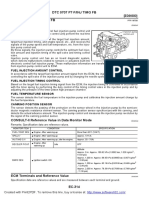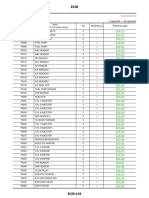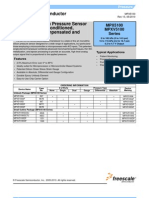Map Sensor Technical Specification
Uploaded by
Edward FisherMap Sensor Technical Specification
Uploaded by
Edward Fisher32
Pressure sensors
Piezoresistive absolute-pressure sensors in thick-film technology
Measurement of pressures in gases up to 250 kPa p U b Thick-film pressuremeasuring element ensures a high degree of measurement sensitivity. b Thick-film sensor element and IC on the same substrate guarantee problem-free signal transmission. b Integrated evaluation circuit for signal amplification, temperature compensation, and characteristic-curve adjustment b Sensor enclosed by robust housing.
Design and function The heart of this sensor is the sensor bubble (pressure-measuring element) produced using 100% thick-film techniques. It is hermetically sealed on a ceramic substrate and contains a given volume of air at a reference pressure of approx. 20 kPa. Piezo-resistive thick-film strain gauges are printed onto the bubble and protected with glass against aggressive media. The strain gauges are characterized by high measurement sensitivity (gauge factor approx. 12), as well as by linear and hysteresis-free behavior. When pressure is applied, they convert mechanical strain into an electric signal. A full-wave bridge circuit provides a measurement signal which is proportional to the applied pressure, and this is amplified by a hybrid circuit on the same substrate. It is therefore impossible for interference to have any effect through the leads to the ECU. DC amplification and individual temperature compensation in the 40 C...+125 C range, produce an analog, ratiometric (i.e. proportional to the supply voltage UV) output voltage UA. The pressure sensors are resistant to gauge pressures up to 600 kPa. Outside the temperature range 10 C...85 C the permissible tolerance increases by the tolerance multiplier. To protect the sensors, the stipulated maximum values for supply voltage, operating-temperature, and maximum pressure are not to be exceeded. Explanation of symbols UV Supply voltage UA Output voltage p Permissible accuracy in the range 10 C...85 C k Tolerance multiplier Temperature pabs Absolute pressure
Characteristic curves 1 (UV = 5 V). pabs UA = UV 0,01 0,12 kPa Characteristic curves 2 (UV = 5 V).
UA = UV
p +0,0061) ( 0,85 230 kPa
abs
p UA kPa V _ 2.0 5 +
p UA kPa V _ + 2.0 5 4 p _ + 1.5 3 _ + 1.0 2 _ + 0.5
0
_ 1.5 + _ 1.0 +
4 3 2
UA
UA
_ 0.5 +
0
1 0 0 20 40 60 80 100 kPa Absolute pressure pabs k 3 2 1 0 -40 0 40 80 Temperature 120 C
1 0 0 100 200 kPa Absolute pressure pabs k 3 2 1 0 -40 0 40 80 Temperature 120 C
Technical data / Range
Part number Characteristic curve Measuring range Max. pressure (1 s, 30 C) Pressure-change time Supply voltage UV Max. supply voltage Input current IV Load impedance RL Operating temperature range Degree of protection 0 261 230 004 1 20105 600 10 4.755.25 16 < 10 > 50 40+125 IP 54 A 0 281 002 119 2 20250 500 10 4.755.25 16 < 10 > 50 40+120
kPa kPa ms V V mA k C
Accessories
Connector 1 237 000 039
Pressure sensors
33
Block diagram. A Strain-gauge pressure-measuring cell, B Amplifier, C Temperature-compensation circuit
Design. 1 Strain-gauge pressure-measuring cell, 2 Plastic housing, 3 Thick-film hybrid (sensor and evaluation circuit), 4 Operational amplifier, 5 Housing cover, 6 Thick-film sensor element (sensor bubble), 7 Aluminum base plate.
UV
Installation instructions A hose forms the connection between the sensor and the gas pressure to be measured. Upon installation, the sensor pressure connection should point downwards to prevent the ingress of moisture. The angular position referred to the vertical must be +20...85, preferably 0. Suggested fastening: M6 screw with spring washer. Connector-pin assignment Terminal 1 +UV Terminal 2 Ground Terminal 3 UA
B C
UA
Dimension drawings.
Point attachment. The housing must not make contact outside this contact area. Torsion resistance must be provided.
6.5
6.9
Pin 3
Pin 2
Pin 1 0.50.2 38.9 13.6 23.3 5.5 Groove 1.2 deep Blind hole 4 deep
16 10.5
34
Pressure sensors
Absolute-pressure sensors in micromechanical hybrid design
Measurement of pressures in gases up to 400 kPa p U b High accuracy. b EMC protection better than 100 V m1. b Temperature-compensated. b Version with additional integral temperature sensor.
Applications This sensor is used to measure the absolute intake-manifold pressure. On the version with integral temperature sensor, the temperature of the drawn-in air flow is also measured. Design and function The piezoresistive pressure-sensor element and suitable electronic circuitry for signalamplification and temperature compensation are mounted on a silicon chip. The measured pressure is applied from above to the diaphragms active surface. A reference vacuum is enclosed between the rear side and the glass base. Thanks to a special coating, both pressure sensor and temperature sensor are insensitive to the gases and liquids which are present in the intake manifold. Installation information The sensor is designed for mounting on a horizontal surface of the vehicles intake manifold. The pressure fitting together with the temperature sensor extend into the manifold and are sealed-off to atmosphere by O-rings. By correct mounting in the vehicle (pressure-monitoring point on the top at the intake manifold, pressure fitting pointing downwards etc.) it is to be ensured that condensate does not collect in the pressure cell.
Range
Pressure Character- Features Dimension Order No. range istic drawing 2) kPa (p1...p2) curve1) 10...115 1 1 B 261 260 136 3) 10...115 1 2 0 261 230 052 20...250 1 1 0 281 002 487 10...115 1 Integral temperature sensor 3 0 261 230 030 20...250 1 Integral temperature sensor 3 0 261 230 042 20...300 1 Integral temperature sensor 3 0 281 002 437 50...350 2 Integral temperature sensor 3 0 281 002 456 50...400 2 Integral temperature sensor 3 B 261 260 508 3) 1) The characteristic-curve tolerance and the tolerance expansion factor apply for all versions, see Page 36 2) See Page 37 3) Provisional draft number, order number available upon enquiry. Available as from about the end of 2001
Accessories
Plug housing Qty. required: 1 4) 1 928 403 966 Plug housing Qty. required: 1 5) 1 928 403 736 Contact pin Qty. required: 3 or 4 6) 1 928 498 060 Individual gasket Qty. required: 3 or 4 6) 1 928 300 599 4) Plug housing for sensors without integral temperature sensor 5) Plug housing for sensors with integral temperature sensor 6) Sensors without temperature sensor each need 3 contacts and gaskets. Sensors with integral temperature sensor each need 4 contacts and gaskets
Pressure sensors
35
Technical data
Operating temperature Supply voltage Current consumption at UV = 5 V Load current at output Load resistance to UV or ground Response time Voltage limitation at UV = 5 V Lower limit Upper limit Limit data Supply voltage Storage temperature
B UV IV IL Rpull-up Rpull-down t10/90
UA min UA max UV max L
C V mA mA k k ms V V V C C mA k s
min. 40 4.5 6.0 1.0 5 10.0 0.25 4.75 40 40
typ. 5.0 9.0 680 100 1.0 0.3 4.8 2.55%
max. +130 5.5 12.5 0.5 0.35 4.85 +16 +130 +130 11) 10 2)
Temperature sensor Measuring range M Measured current IM Nominal resistance at +20 C Thermal time constant t63 1) Operation at 5 V with 1 k series resistor 2) In air with a flow rate of 6 m s1
Sectional view. Section through the sensor cell
Section through the DS-S2 pressure sensor
Section through the sensor cell. 1 Protective gel, 2 Pressure, 3 Sensor chip, 4 Bonded connection, 5 Ceramic substrate, 6 Glass base. Section through the pressure sensor. 1 Bonded connection, 2 Cover, 3 Sensor chip, 4 Ceramic substrate, 5 Housing with pressure-sensor fitting, 6 Gasket, 7 NTC element.
4 5 1 3 6 4 7 5 6
Signal evaluation: Recommendation. R Reference D Pressure signal T Temperature signal
UH 680 k OUT 68 k R D T 1,5 nF 33 nF 5,5 bis 16 V US 5V
ADC
P U
NTC
VCC
Signal evaluation: Recommendation. The pressure sensors electrical output is so designed that malfunctions caused by cable open-circuits or short circuits can be detected by a suitable circuit in the following electronic circuitry. The diagnosis areas situated outside the characteristiccurve limits are provided for fault diagnosis. The circuit diagram shows an example for detection of all malfunctions via signal outside the characteristic-curve limitation.
NTC
1,5 nF
2,61 k 10 k
GND
1,5 nF
38,3 k
33 nF
Pressure sensor
ECU
36
Pressure sensors
Absolute-pressure sensors in micromechanical hybrid design (contd.) Measurement of pressures in gases up to 400 kPa
Characteristic curve 1 (UV = 5.0 V).
V 5 4,65 Output voltage UA
Characteristic-curve tolerance.
Temperature-sensor characteristic curve.
105
Tolerance (% FS)
4 3 2 1 0,40 0
1.5
Resistance R 104
0 p1 - 1.5 p2
R=f( )
103
102
P1
Pressure p
P2
kPa
Absolute pressure p
40
40 80 Temperature
120 C
Characteristic curve (UV = 5.0 V).
Tolerance-expansion factor.
V 5 4,50 4 Output voltage UA 3 2 1 0,50 0
0 Factor 1 1.5
Explanation of symbols. UA Output voltage UV Supply voltage k Tolerance multiplier D After continuous operation N As-new state
0.5
P1
Pressure p
P2
kPa
-40
10 Temperature
110 130 C
Pressure sensors
37
Dimensions drawings.
1
Connector-pin assignment Pin 1 +5 V Pin 2 Ground Pin 3 Output signal
2
Connector-pin assignment Pin 1 +5 V Pin 2 Ground Pin 3 Output signal
3
Connector-pin assignment Pin 1 Ground Pin 2 NTC resistor Pin 3 +5 V Pin 4 Output signal
B 60 33
19
20
13
15
13
12 12 12
56
23
A 38
C 48
72
A
3 2 1
B
3 2 1
C
4 3 2 1
22
15
38
Pressure sensors
Piezoresistive absolute-pressure sensor with moulded cable
Measurement of pressures in gases up to 400 kPa p U b Pressure-measuring element with silicon diaphragm ensures extremely high accuracy and long-term stability. b Integrated evaluation circuit for signal amplification and characteristic-curve adjustment. b Very robust construction.
Applications This type of absolute-pressure sensor is highly suitable for measuring the boost pressure in the intake manifold of turbocharged diesel engines. They are needed in such engine assemblies for boostpressure control and smoke limitation. Design and function The sensors are provided with a pressureconnection fitting with O-ring so that they can be fitted directly at the measurement point without the complication and costs of installing special hoses. They are extremely robust and insensitive to aggressive media such as oils, fuels, brake fluids, saline fog, and industrial climate. In the measuring process, pressure is applied to a silicon diaphragm to which are attached piezoresistive resistors. Using their integrated electronic circuitry, the sensors provide an output signal the voltage of which is proportional to the applied pressure. Installation information The metal bushings at the fastening holes are designed for tightening torques of maximum 10 N m. When installed, the pressure fitting must point downwards. The pressure fittings angle referred to the vertical must not exceed 60. Tolerances In the basic temperature range, the maximum pressure-measuring error p (referred to the excursion: 400 kPa50 kPa = 350 kPa) is as follows: Pressure range 70...360 kPa As-new state 1.0 % After endurance test 1.2 % Pressure range < 70 and > 360 kPa (linear increase) As-new state 1.8 % After endurance test 2.0 %
Technical data / Range
Part number Measuring range Basic measuring range with enhanced accuracy Resistance to overpressure Ambient temperature range/sustained temperature range Basic range with enhanced accuracy Limit-temperature range, short-time Supply voltage UV Current input IV Polarity-reversal strength at IV 100 mA Short-circuit strength, output Permissible loading Pull down Response time t10/90 Vibration loading max. Protection against water Strong hose water at increased pressure High-pressure and steam-jet cleaning Protection against dust 0 281 002 257 50...400 kPa 70...360 kPa 600 kPa 40...+120 C +20...+110 C 140 C 5 V 10 % 12 mA UV To ground and UV 100 k 100 nF 5 ms 20 g IPX6K IPX9K IP6KX
Throughout the complete temperature range, the permissible temperature error results from multiplying the maximum permissible pressure measuring error by the temperature-error multiplier corresponding to the temperature in question. Basic temperature +20...+110 C 1.0 1) range +20... 40 C 3.0 1) +110...+120 C 1.6 1) +120...+140 C 2.0 1) 1) In each case, increasing linearly to the given value.
Accessories
Connector 1 237 000 039
Pressure sensors
39
Characteristic curve (UV = 5 V). UA
V 4
U A = UV
Maximum permissible pressure-measuring error.
Temperature-error multiplier.
p abs - 1 437.5 kPa 70
Error % of stroke, mV 2.0%, 80 1.8%, 72
k 3
2 1.2%, 48 1.0%, 40
D N
1.6 1
50 100
200
300 kPa 400
50
70
360
400 kPa
-40
+20
110 120
140 C
Absolute pressure pabs
Absolute pressure p abs
Temperature
Dimension drawings. S 3-pole plug O1 O-ring dia. 11.5x2.5 mm HNBR-75-ShA
Explanation of symbols UV Supply voltage UA Output voltage (signal voltage) k Temperature-error multiplier pabs Absolute pressure g Acceleration due to gravity 9.81 m s2 D After endurance test N As-new state Connector-pin assignment Pin 1 UA Pin 2 +5 V Pin 3 Ground
150 10
15,8 - 0,2 11,9 0,15
55,1
25
6,6 0,2 48,4 0,15 62,4
15,9 1,2 x 45 3,6 0,3 7 0,3 9,3 0,3 27,8 29,6
- 0,2
3 2 1
6 0,3
22,5 6,5 0,2
40
Pressure sensors
Medium-resistant absolute-pressure sensors Micromechanical type
Measurement of pressure in gases and liquid mediums up to 600 kPa p U b Delivery possible either without housing or inside rugged housing. b EMC protection up to 100 V m1. b Temperature-compensated. b Ratiometric output signal. b All sensors and sensor cells are resistive to fuels (incl. diesel), and oils such as engine lube oils. 14 2
3
Applications These monolithic integrated silicon pressure sensors are high-precision measuring elements for measuring the absolute pressure. They are particularly suitable for oper-ations in hostile environments, for instance for measuring the absolute manifold pressure in internalcombustion engines. Design and function The sensor contains a silicon chip with etched pressure diaphragm. When a change in pressure takes place, the diaphragm is stretched and the resulting change in resistance is registered by an evaluation circuit. This evaluation circuit is integrated on the silicon chip together with the electronic calibration elements. During production of the silicon chip, a silicon wafer on which there are a number of sensor elements, is bonded to a glass plate. After sawing the plate into chips, the individual chips are soldered onto a metal base complete with pressure connection fitting. When pressure is applied, this is directed through the fitting and the base to the rear side of the pressure diaphragm. There is a reference vacuum trapped underneath the cap welded to the base. This permits the absolute pressure to be measured as well as protecting the front side of the pressure diaphragm. The programming logic integrated on the chip performs a calibration whereby the calibration parameters are permanently stored by means of thyristors (ZenerZapping) and etched conductive paths. The calibrated and tested sensors are mounted in a special housing for attachment to the intake manifold.
56
Signal evaluation The pressure sensor delivers an analog output signal which is ratiometric referred to the supply voltage. In the input stage of the downstream electronics, we recommend the use of an RC low-pass filter with, for instance, t = 2 ms, in order to suppress any disturbance harmonics which may occur. In the version with integrated temperature sensor, the sensor is in the form of an NTC resistor (to be operated with series resistor) for measuring the ambient temperature. Installation information When installed, the pressure connection fitting must point downwards in order that condensate cannot form in the pressure cell.
Construction Sensors with housing: This version is equipped with a robust housing. In the version with temperature sensor, the sensor is incorporated in the housing. Sensors without housing: Casing similar to TO case, pressure is applied through a central pressure fitting. Of the available soldering pins the following are needed: Pin 6 Output voltage UA, Pin 7 Ground, Pin 8 +5 V.
Pressure sensors
41
Range
Pressure sensor integrated in rugged, media-resistant housing Pressure range Chara. Features Dimension kPa (p1...p2) curve 1) drawing 2) 20...115 1 4 1 20...250 1 4 1 10...115 1 Integrated temperature sensor 2 2 20...115 1 Integrated temperature sensor 2 2 20...250 1 Integrated temperature sensor 2 2 50...350 2 Integrated temperature sensor 5 (5) 3) 50...400 2 Integrated temperature sensor 50...600 2 Integrated temperature sensor 6 6 10...115 1 Hose connection 1 (1) 3) 15...380 2 Clip-type module with 3 3 connection cable Part number 0 261 230 020 0 281 002 137 0 261 230 022 0 261 230 013 0 281 002 205 0 281 002 244 0 281 002 316 0 281 002 420 0 261 230 009 1 267 030 835
Accessories
For 0 261 230 009, .. 020; 0 281 002 137 Plug housing 1 928 403 870 Contact pin 2-929 939-1 4) Individual gasket 1 987 280 106 For 0 261 230 013, .. 022; 0 281 002 205, ..420 Plug housing 1 928 403 913 Contact pin 2-929 939-1 4) Individual gasket 1 987 280 106 For 0 281 002 244 Plug housing Contact pin Individual gasket For 0 281 002 420 Plug housing Contact pin Individual gasket 1 928 403 913 2-929 939-6 4) 1 987 280 106 1 928 403 736 1 928 498 060 1 928 300 599
Pressure-sensor cells in casings similar to transistors Suitable for installation inside devices Pressure range Chara. Features Dimension Part number kPa (p1...p2) curve 1) drawing 2) 10...115 1 7 7 0 273 300 006 15...380 2 7 7 0 273 300 017 15...380 2 8 (7) 3) 0 261 230 036 20...105 1 7 7 0 273 300 001 20...115 1 7 7 0 273 300 002 20...250 1 7 7 0 273 300 004 50...350 2 7 7 0 273 300 010 50...400 2 7 7 0 273 300 019 50...400 2 8 (7) 3) 0 261 230 033 50...600 2 7 7 0 273 300 012 1) The characteristic-curve tolerance and the tolerance extension factor apply to all versions, refer to Page 42. 2) See Page 43/44 3) For similar drawing, see dimension drawing on Pages 43/44 4) To be obtained from AMP Deutschland GmbH, Amperestr. 711, D-63225 Langen, Tel. 0 61 03/7 09-0, Fax 0 61 03/7 09 12 23, E-Mail: AMP.Kontakt@tycoelectronics.com
Note Each 3-pole plug requires 1 plug housing, 3 contact pins, and 3 individual gaskets. 4-pole plugs require 1 plug housing, 4 contact pins, and 4 individual gaskets.
Technical data
Supply voltage UV Current input IV at UV = 5 V Load current at output Load resistance to ground or UV Lower limit at UV = 5 V Upper limit at UV = 5 V Output resistance to ground UV open Output resistance to UV, ground open Response time t10/90 Operating temperature Limit data Supply voltage UV Operating temperature Recommendation for signal evaluation Load resistance to UH = 5.5...16 V Load resistance to ground Low-pass resistance Low-pass capacitance Temperature sensor Measuring range Nominal voltage Measured current at +20 C Temperature time constant t63 6) 5) Operation with series resistor 1 k. 6) In air with airflow speed 6 m s1. V mA mA k V V k k ms C V C k k k nF C mA k s min. 4.5 6 0.1 50 0.25 4.75 2.4 3.4 40 40 40 typical 5 9 0.30 4.80 4.7 5.3 0.2 680 100 21.5 100 2,5 5 % max. 5.5 12.5 0.1 0.35 4.85 8.2 8.2 +125 16 +130 +125 1 5) 45
42
Pressure sensors
Micromechanical TO-design absolute-pressure sensors (contd.) Measurement of pressures in gases and liquid media up to 600 kPa
Characteristic curve 1 (UV = 5.0 V).
V 5 4,65 4 Output voltage UA 3 2 1
Characteristic-curve tolerance.
p % p 3
Temperature-sensor characteristic curve.
105
Resistance R
1 P1 0 0,2 0,4 0,6 0,8 P2 1,0
104
R=f( )
103
-1 0,40 0 P1 P2 kPa
Pressure p
-2
Characteristic curve 2 (UV = 5.0 V).
-3 Pressure p kPa
102 40 0 40 80 Temperature 120 C
Tolerance extension factor.
k 3 2 D 1 N
Explanation of symbols UA Output voltage UV Supply voltage k Tolerance multiplication factor D Following endurance test N As-new state
-40
40
80
120 C
Temperature
Block diagram. E Characteristic curve: Sensitivity, K Compensation circuit O Characteristic curve: Offset, S Sensor bridge, V Amplifier
Sectional views. Pressure sensor in housing. 1 Pressure sensor, 2 pcb, 3 Pressure fitting, 4 Housing, 5 Temperature sensor, 6 Electrical bushing, 7 Glass insulation, 8 Reference vacuum, 9 Aluminum connection (bonding wire), 10 Sensor chip, 11 Glass base, 12 Welded connection, 13 Soldered connection.
10
11
13
12
Section through the installed pressure sensor.
S V
Installed pressure sensor. Version with temperature sensor.
2 1
E, K, O
Pressure sensors
43
Dimension drawings. P Space required by plug and cable.
1 0 261 230 009
Connector-pin assignment Pin 1 +5 V Pin 2 Ground Pin 3 Output signal
11,7 0,15
2 0 261 230 013, 0 261 230 022, 0 281 002 205
Connector-pin assignment Pin 1 Ground Pin 2 NTC resistor Pin 3 +5 V Pin 4 Output signal
58 39
3,5 min. 1
R 10 min. 4
18
8,85 0 11,7 0,15 7,8 0,15 20 26,7 X
70
X
70
15
7,8
0,15
26,7
5 min. 1
28,2
17,6 15,5 min. 4 P
15,1
12
6,8
27
4 3
1 2 3 4
+6 0 -60
20 min. 35
49 36
6,6 16,2 20
3 1 267 030 835
Connector-pin assignment Pin 1 Ground Pin 2 +5 V Pin 3 Vacant Pin 4 Output signal
3,6 - 0,1 (3x)
4 0 261 230 020, 0 281 002 137
Connector-pin assignment Pin 1 +5 V R 10 Pin 2 Ground Pin 3 Output signal
0,25 25 + - 0,05 0,05 17 + - 0,25 0,05 5,6 + - 0,15
2,6 0,45 3,8 0,1 1,5 0,05
12
7 0,05 1,5 + - 0,15 (3x) 1 0,15 (3x)
2 1
0,25 16 + - 0,05
0,25 20 + - 0,05
19,5
60 (3x)
15,1
11,85 0,1
70 5
30
17
3 2 1
0,3 12,5 + - 0,5
20 16,2
12 0,5
2,3 0,3
4 0,5
28,2
57
15
44
Pressure sensors
Micromechanical TO-design absolute-pressure sensors (contd.) Measurement of pressures in gases and liquid media up to 600 kPa
Dimension drawings A Space required by plug and cable B Space required when plugging in/unplugging
5 0 281 002 244
Connector-pin assignment Pin 1 Ground Pin 2 NTC resistor Pin 3 +5 V Pin 4 Output signal
7 0 273 300 ..
Sensor without housing D Pressure-connection fitting Pin 6 Output signal Pin 7 Soldered
min.3 6 min.1
58 39 16,6
18
1,5 0,1
9,3
30
min.1
8,5
PIN 8 D 7,62 PIN 7 PIN 6
15,5 17,7 0,2 18 36 0,3 9,5 18
4 3 2 1
12,5 1,7 max.
54
AIR
73
7,6
0,15 0,8 + - 0,05
1,5
8 0 261 230 036 .. 6 0 281 002 246
Connector-pin assignment Pin 1 Ground Pin 2 NTC resistor Pin 3 +5 V Pin 4 Output signal D Pressure connection L In the area of the measuring surface
min.3 6 . min 1
58 39 16,6
12,7
15
18
10
55
11,4 0,2 6,4 0,3
27
2,1 17,7 0,2 18 18
8,5 0,25
6,3 2,1 15,5
min.1
8,5
8,8 0,4
12
1,5 0,1 D 1,5 (3x)
36 0,3
9,5
4 3 2 1
54
73
13,6 0,25
OIL
6,9
6,7
7,6
5,2
13,9
0,5 12,7 + - 0,1
10
1 min.2 ,5 4 min.1
15
2,54
2,5
58
7,62 2,54
1 min.2 ,5 4 min.1 2,5
You might also like
- RB25DET - Neo, A/T (R34) ,: Preecha Jiangjuntr, 0814338599100% (2)RB25DET - Neo, A/T (R34) ,: Preecha Jiangjuntr, 08143385993 pages
- Tyco Rele EC V23078-c1002-A303 DatasheetNo ratings yetTyco Rele EC V23078-c1002-A303 Datasheet5 pages
- Diesel Injection: Fault Finding - Fault Summary TableNo ratings yetDiesel Injection: Fault Finding - Fault Summary Table3 pages
- DTC 0707 P7 F/Inj Timg FB DTC 0707 P7 F/Inj Timg FB DescriptionNo ratings yetDTC 0707 P7 F/Inj Timg FB DTC 0707 P7 F/Inj Timg FB Description6 pages
- Caracteristicas Del Sensor de Temperatura Corsa Marca DelphiNo ratings yetCaracteristicas Del Sensor de Temperatura Corsa Marca Delphi4 pages
- Ecu (Engine Control Unit - DSL) : 5-8 Electrical Wiring DiagramsNo ratings yetEcu (Engine Control Unit - DSL) : 5-8 Electrical Wiring Diagrams8 pages
- JLR 13 65 10 - 1E - Defender Puma 60th Anniversary Electric Wiring Diagrams - SupplementNo ratings yetJLR 13 65 10 - 1E - Defender Puma 60th Anniversary Electric Wiring Diagrams - Supplement24 pages
- Engine Control System 1. General: Engine - 2Tr-Fe Engine EG-31100% (1)Engine Control System 1. General: Engine - 2Tr-Fe Engine EG-3132 pages
- Description: Eps System Description - Eps ControlNo ratings yetDescription: Eps System Description - Eps Control34 pages
- Information Service: Electric EGR Valves (Renault, Opel)100% (1)Information Service: Electric EGR Valves (Renault, Opel)3 pages
- DTC P1550 Battery Current Sensor Circuit DTC P1551 Battery Current Sensor Circuit Low DTC P1552 Battery Current Sensor Circuit High100% (1)DTC P1550 Battery Current Sensor Circuit DTC P1551 Battery Current Sensor Circuit Low DTC P1552 Battery Current Sensor Circuit High3 pages
- Freescale Semiconductor Integrated Silicon Pressure Sensor On-Chip Signal Conditioned, Temperature Compensated and CalibratedNo ratings yetFreescale Semiconductor Integrated Silicon Pressure Sensor On-Chip Signal Conditioned, Temperature Compensated and Calibrated10 pages
- Freescale Semiconductor Integrated Silicon Pressure Sensor On-Chip Signal Conditioned, Temperature Compensated and CalibratedNo ratings yetFreescale Semiconductor Integrated Silicon Pressure Sensor On-Chip Signal Conditioned, Temperature Compensated and Calibrated7 pages
- Analysis of Fast Transient Voltage Distributions in Transformer Windings Under Different Insulation ConditionsNo ratings yetAnalysis of Fast Transient Voltage Distributions in Transformer Windings Under Different Insulation Conditions8 pages
- Q.P. Xi Physics H.y.exam 2023-24 KVS Ro Lko. 1No ratings yetQ.P. Xi Physics H.y.exam 2023-24 KVS Ro Lko. 110 pages
- TRM-1A: Transformer Winding Resistance MeterNo ratings yetTRM-1A: Transformer Winding Resistance Meter2 pages
- Aapt United States Physics Team AIP 2010: Do Not Distribute This PageNo ratings yetAapt United States Physics Team AIP 2010: Do Not Distribute This Page15 pages
- Experiment Instructions: HM 150.13 Methods of Flow MeasurementNo ratings yetExperiment Instructions: HM 150.13 Methods of Flow Measurement30 pages
- XI' Physics Examination 2022: Section A' (Multiple Choice Questions)No ratings yetXI' Physics Examination 2022: Section A' (Multiple Choice Questions)4 pages
- Stability Analysis of Floating Body: Title ObjectiveNo ratings yetStability Analysis of Floating Body: Title Objective2 pages
- This Study Resource Was Shared Via: Tutorial Questions For Topic 1&2 20S1 MA4842No ratings yetThis Study Resource Was Shared Via: Tutorial Questions For Topic 1&2 20S1 MA48425 pages
- Advance E-Bike-WPS Office-1 Hari Hari Hari Hari HariNo ratings yetAdvance E-Bike-WPS Office-1 Hari Hari Hari Hari Hari26 pages
- RB25DET - Neo, A/T (R34) ,: Preecha Jiangjuntr, 0814338599RB25DET - Neo, A/T (R34) ,: Preecha Jiangjuntr, 0814338599
- Diesel Injection: Fault Finding - Fault Summary TableDiesel Injection: Fault Finding - Fault Summary Table
- DTC 0707 P7 F/Inj Timg FB DTC 0707 P7 F/Inj Timg FB DescriptionDTC 0707 P7 F/Inj Timg FB DTC 0707 P7 F/Inj Timg FB Description
- Caracteristicas Del Sensor de Temperatura Corsa Marca DelphiCaracteristicas Del Sensor de Temperatura Corsa Marca Delphi
- Ecu (Engine Control Unit - DSL) : 5-8 Electrical Wiring DiagramsEcu (Engine Control Unit - DSL) : 5-8 Electrical Wiring Diagrams
- JLR 13 65 10 - 1E - Defender Puma 60th Anniversary Electric Wiring Diagrams - SupplementJLR 13 65 10 - 1E - Defender Puma 60th Anniversary Electric Wiring Diagrams - Supplement
- Engine Control System 1. General: Engine - 2Tr-Fe Engine EG-31Engine Control System 1. General: Engine - 2Tr-Fe Engine EG-31
- Information Service: Electric EGR Valves (Renault, Opel)Information Service: Electric EGR Valves (Renault, Opel)
- DTC P1550 Battery Current Sensor Circuit DTC P1551 Battery Current Sensor Circuit Low DTC P1552 Battery Current Sensor Circuit HighDTC P1550 Battery Current Sensor Circuit DTC P1551 Battery Current Sensor Circuit Low DTC P1552 Battery Current Sensor Circuit High
- Freescale Semiconductor Integrated Silicon Pressure Sensor On-Chip Signal Conditioned, Temperature Compensated and CalibratedFreescale Semiconductor Integrated Silicon Pressure Sensor On-Chip Signal Conditioned, Temperature Compensated and Calibrated
- Freescale Semiconductor Integrated Silicon Pressure Sensor On-Chip Signal Conditioned, Temperature Compensated and CalibratedFreescale Semiconductor Integrated Silicon Pressure Sensor On-Chip Signal Conditioned, Temperature Compensated and Calibrated
- Analysis of Fast Transient Voltage Distributions in Transformer Windings Under Different Insulation ConditionsAnalysis of Fast Transient Voltage Distributions in Transformer Windings Under Different Insulation Conditions
- Aapt United States Physics Team AIP 2010: Do Not Distribute This PageAapt United States Physics Team AIP 2010: Do Not Distribute This Page
- Experiment Instructions: HM 150.13 Methods of Flow MeasurementExperiment Instructions: HM 150.13 Methods of Flow Measurement
- XI' Physics Examination 2022: Section A' (Multiple Choice Questions)XI' Physics Examination 2022: Section A' (Multiple Choice Questions)
- Stability Analysis of Floating Body: Title ObjectiveStability Analysis of Floating Body: Title Objective
- This Study Resource Was Shared Via: Tutorial Questions For Topic 1&2 20S1 MA4842This Study Resource Was Shared Via: Tutorial Questions For Topic 1&2 20S1 MA4842
- Advance E-Bike-WPS Office-1 Hari Hari Hari Hari HariAdvance E-Bike-WPS Office-1 Hari Hari Hari Hari Hari

























































































